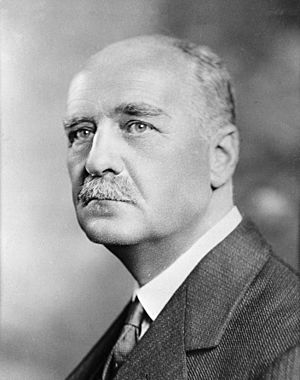Joseph Barcroft facts for kids
Quick facts for kids
Joseph Barcroft
|
|
|---|---|

Joseph Barcroft c. 1940
|
|
| Scientific career | |
| Doctoral students | |
| Influenced |
|
Sir Joseph Barcroft CBE FRS (born July 26, 1872 – died March 21, 1947) was a famous British scientist who studied how our bodies use oxygen. He was especially known for his work on how blood carries oxygen. He was a physiologist, which is a scientist who studies how living things work.
Contents
Early Life and Education
Joseph Barcroft was born in Newry, County Down, which is now in Northern Ireland. His family were Quakers. He went to school at Bootham School in York and later at The Leys School in Cambridge. In 1903, he married Mary Agnetta Ball.
He earned his degree in Medicine and Science from Cambridge University in 1896. Right after graduating, he began his important studies on haemoglobin. Haemoglobin is the part of your blood that carries oxygen around your body.
Scientific Achievements
Joseph Barcroft received many important awards for his scientific work. In May 1910, he was chosen as a Fellow of the Royal Society. This is a very high honor for scientists in the United Kingdom. He later received their Royal Medal in 1922 and the Copley medal in 1943. He also gave a special lecture called the Croonian Lecture in 1935.
Research on Oxygen and Blood
Barcroft's main research focused on how oxygen moves into the blood and how the body uses it. He wanted to understand how our bodies get enough oxygen to survive, especially in difficult conditions.
Self-Experimentation
To learn more about how the body works, Joseph Barcroft sometimes used himself for experiments. For example, during the First World War, he studied poisonous gases. He even exposed himself to a small amount of hydrogen cyanide gas to understand its effects.
Another time, he stayed in a sealed glass room for seven days. He did this to figure out the smallest amount of oxygen a person needs to live. He also exposed himself to very cold temperatures to study how the body reacts. These experiments showed how dedicated he was to understanding human physiology.
High-Altitude Expeditions
Barcroft also studied how the body uses oxygen at very high places, like on mountains. He organized trips to tall peaks to do this research. These expeditions included trips to Tenerife in 1910, Monte Rosa in 1911, and the Peruvian Andes mountains in 1922. His work helped us understand how people can adapt to less oxygen at high altitudes.
Later Career and Research
From 1925 to 1937, Joseph Barcroft was a professor of physiology at Cambridge University. His last major research project, which he started in 1933, was about how fetuses (unborn babies) breathe and get oxygen. This was a very important area of study.
War Contributions and Honors
During both the First World War and the Second World War, Barcroft played a key role as the Chief Physiologist at the Gas Warfare Centre at Porton Down. He helped scientists understand the effects of chemical weapons.
For his important contributions, he was given the title of Commander of the Order of the British Empire (CBE) in 1918. He was also made a knight in 1935, which meant he could use the title "Sir." In 1938, he became an honorary member of the American Academy of Arts and Sciences.
Sir Joseph Barcroft passed away in Cambridge in 1947. His work greatly advanced our understanding of oxygen and blood.
See also
 In Spanish: Joseph Barcroft para niños
In Spanish: Joseph Barcroft para niños

